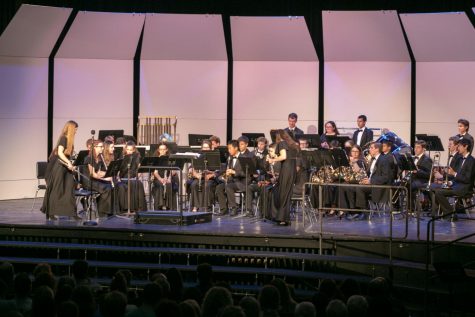Unsafe Conditions Force Shutdown of DHS Auditorium
February 6, 2020

There are very few high schools that make use of their auditorium in the unique way that DHS does–what is typically a space used only for theatrical productions is the performance and presentation spot for a breadth of classes, clubs, and extracurriculars of all kinds. The DHS auditorium is the place to be for any event that gathers a large crowd, which is what makes it so crucial to the school community. However, the auditorium’s stage was shut down in November because of structural issues that presented a safety hazard. As of this publication of Deerprints, a temporary fix to the staging issues in the auditorium is currently in the works so that it will be usable for the rest of the 2020 school year, and come springtime in 2021, a long-overdue renovation of the auditorium will commence.
Back in October of 2019, an inspection of the auditorium revealed some much needed repair on the rigging system of the stage. By November, Judy Brady, an outside architect and structural engineer, and Protolight, the stage-building company she was consulting with, were hard at work figuring out how to get things up and running again. The process is a little complicated because the auditorium’s stage hasn’t needed such intensive maintenance in so long. A lot of the work comes from the need to plan–for any new lights to be installed on the rigging system there must be back-and-forth communication between Brady, Protolight, and DHS’s own team overseeing the project to make sure that any additions to the system are physically possible for our stage and thus structurally sound when installed. As of this printing, the stage has been cleared for rehearsals. Protolight stripped the rigging in November, so that’s no longer an issue, but there currently aren’t any lights on the stage. DHS is waiting on Protolight for the pricing of the installation. Once Protolight comes back with a price, the Board of Education can approve the project and then installation will begin.
Superintendent Bruce Law is naturally the administrator overseeing the repairs, and he explained that while it is normal for an auditorium as old as DHS’s to have problems like this, the issue did remind the Board that it is time for larger renovations to take place. The timing was certainly unfortunate, with the S.T.U.N.T.S. production board and School Chest groups relying so heavily on a stage for their presentations, but the Board decided that during this interim period, it wouldn’t make sense to start making any changes beyond fixing the rigging. This construction will therefore be a temporary fix–enough to repair the cable system so it is safe to use and able to get everyone through the rest of this school year and the first half of the next. Then, in the spring of 2021, the larger renovation will begin.
Dr. Law explained, “With construction in schools, you have to work a long way out. Once you start construction, the project just goes forward. It takes a long time to get there, though.” At this point in the process, the Board has already picked the DHS auditorium as their next official project alongside Highland Park High School’s cafeteria, but it still needs to have a meeting that addresses different possible options for renovation, which will most likely take place sometime in March.
Dr. Law is working with students, faculty, and community members to develop these options and hopes to come up with at least three. One option would be to completely replace the entire auditorium, but others may involve less drastic changes. Renovation was originally planned for the summer of 2020, but with the discovery of the faulty rigging, the finishing date is pushed to summer 2021.
Dr. Law also mentioned how he is working with several groups to help create design objectives for the space. These groups will create different sets of criteria for what it is they want the auditorium’s design to achieve, and the Board will then use this criteria to gauge which of the options presented to them is best. This is a standard part of the process for many of the Board’s construction projects–the main goal is always to make sure that whatever design option is chosen meets the needs of the people who will be utilizing the project when its finished.
In terms of cost, the District administrators estimate that construction on the auditorium will be approximately $20 million. For planning purposes they chose the most expensive design option–but this number could change depending on which option is chosen. The repairs going on currently are being paid for with money in the District’s reserves–there is about $5 million set aside every year which is designated for building maintenance that will cover it. For funding the larger construction project in 2021, Dr. Law explained that one option is to use revenue bonds, which would not increase taxes of District 113 residents like past projects that have relied on referenda. Another option is to take some money from the reserves, which will probably happen in addition to the sale of revenue bonds. District administrators are still discussing the possible options with the Board for how to fund this project, but it will definitely not come from an increase in taxes for community members.
The DHS auditorium, though it is used by all, has always played an integral role in R-Hall. Many of its performances take place on the stage, so it’s no surprise that it was affected the most by the recent shut-down. Choir Director Alicia Akers knows very well how many of her students and other performers have had to work around the closing of the stage in recent months. Fall play II, You Can’t Take It With You, had its opening night the day after the stage was deemed unsafe to use. Though it took place in the Studio theatre, crew members used the auditorium for sound and light direction and many cast members relied on the stage as a sort of shortcut when they needed to get around quickly during a show. The S.T.U.N.T.S. Board’s 2019 production, Dreams, Nightmares and S.T.U.N.T.S., was moved to Highland Park High School’s auditorium, which performers made the best of. However, Akers mentioned that it was quite inconvenient when it came to moving instruments, props, and set pieces.
Recent and upcoming shows such as the winter band concert, winter orchestra concert, and the spring musical Mamma Mia face a similar dilemma. Though the musical cast now has a place to practice, since the stage was cleared, there is still the question of lights come showtime. The band and orchestra had their concerts recently–January 28th and 29th, respectively–so DHS had to rent lights to use. Despite the struggles, R-Hall seems to be getting along quite well. Akers said, “Regardless of what’s happening, the people who are invested in the auditorium are what made it so great in the first place. It doesn’t matter where the performance happens, because it has always been about the people.”


